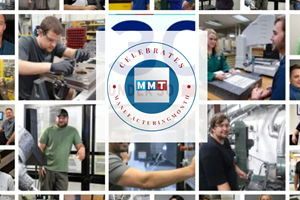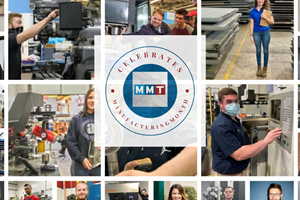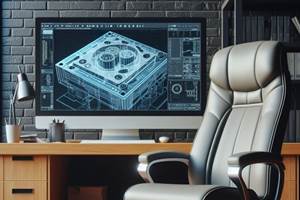Part Two of a Two-Part Series Defining and Developing a Training System that Works
To build an effective training system shops must take into consideration management and employees' technical skills.
The difficulty we face identifying good training programs revolves around proving they work. There always will be people who had the experience of inadequate training and they are the first to say, "Training doesn't work!" The unfortunate part is, in many cases, it is a reality because training sometimes gets fragmented and lacks a place in the overall plan. To define a system that works, you will need to know where you are before you begin. Once you establish that, you will know how far you went and in what direction.
The Biggest Hurdle-Employee Attitudes about Testing
One of the biggest problems to face has to do with a mindset created by the home and school environment in which we were all raised. Aversions to testing have been influenced by our experience in our educational systems. Fear of failure has been associated with testing all of our adolescent lives. This challenge made us realize we need to rethink some of society's most valued measurements of training assessment-the test.
Rethinking the Value of Testing
Tests should be re-evaluated for use with adults. If training needs should be established, the only way to find out if you don't know something is to take a test. Competency tests are seldom used to evaluate training. Training should be like our life experience.
Trainers need to give a test before they administer training to see if it is necessary. I have heard more than one employee complain about training being a waste of time because they already felt they knew the information. In general, most employees want training if they can make time for it. In instances where we found some reluctance, it always seemed to be due to communication or misapplied learning methods that suited the employee.
In dealing with the workforce in the moldmaking industry, employees that left school too early or did not have the opportunity for schooling had difficulty in communicating with reading and writing. When training requires taking a test, they resist the training for fear of being embarrassed by taking the test and failing. Organizations with employees that have been unable to master the reading and writing communicating skills, will find that the most efficient way of training is in a classroom where discussions can take place to augment the reading and writing skills. This probably explains why hands-on training is the most effective way of learning.
As a solution to encourage employees to take training, tests should not have any bearing on passing or failing the training. It is only an assessment to see how much learning took place. Two tests should be given: one before the training and one after. The purpose should be to measure the amount of learning that took place and make adjustments in training methods.
An Effective Training Model
To understand the entire concept of training, we must look at the best training model around today, our military forces. One common element in military training through the years is its ability to change when the goal changes. The main thing we can learn from the military is how to provide any organization with an effective, technology-based training system as the organizational goals change and evolve. Training is all about performance and linking actual employee development with business goals. To do this you must start with the end in mind. Then build your training system around that goal.
When asked what kind of training systems most employees and organizations need, they will select the ones that do not infringe on the employee's personal time or detract from productive work time, which makes the preferred training self-paced and away from the work environment. The cost of travel and being away from home makes remote training too expensive and inconvenient. The best scenario focuses on training either right before or after work at the organization. This minimizes travel time and is very convenient.
A training system is more than just information, banks of videotape presentations and a series of seminars. A good training system will address the organization's unique needs and training styles for the different parts of the organization. When this type of training system is implemented it will pay off in increased productivity, lowered incidents of poor quality and better worker satisfaction.
Management
The most important factor in a successful training system is management. The training management system can best be defined as a network of interdependent components working together to accomplish the business process target. In order to make training systems effective, training should be treated like any other department in the organization such as production, finance and quality control. If the training structure is designed and built with care, all that remains is to allocate resources, determine how to apply them and maintain records. A training program should outline what you want to accomplish and how to achieve it.
Types of Training
There are two different types of training: one for employees that requires a skilled task be completed, and another for employees who are not required to perform a skilled task, but need profound knowledge.
Technical Skill-Training Model
The technical skill-training model is the most fundamental for the skilled employee. This type of training is used to make sure those using a skill are competent. This model can be developed and applied across any organization at the different functional departments that require technical skill training. The Technical Skill Training Model consists of:
- "I know skill level" (exchange of information)
- "I can do skill level"(performance-based instruction-skill transfer)
- "I can adopt and apply skill" (actual on-the-job performance requirement)
Most training programs typically only address the first two levels. They rarely use the "I can adapt and apply skill level," a hands-on demonstration that the employee can perform a function correctly when asked. Technical skill training methods that only put out information and expect a change in behavior, have contributed heavily to the skeptics that deem training as useless. Technical training is more than just receiving information. This type of training should change the way you do your job, the way you react to an urgent situation. For example, moldmakers should be trained to react to specific situations and perform exact operations in the correct sequence to minimize scrap and produce good parts. Their technical training program should provide them with the correct procedure. They should practice the procedures until they are confident their new behavior patterns have changed and they can demonstrate it when asked.
Basic Knowledge Training Model
The second type of training is knowledge-based and presented in a classroom setting that is divided into three categories:
- Basic 101 Training
This is aimed at understanding the organizational functions. It is used to support employees that are required to perform necessary tasks in order for the organization to function. The purpose of basic training is to help the employee to understand how the organization operates, how the interdisciplines work in the moldmaking process and how they fit in. Most organizations ignore this type of training and leave it up to the employee's peers or the supervisors. It does take place informally and inevitably costs organizations more money than they may realize. However, mistakes, frustration, guesswork, worrying and perhaps even severe side effects can usually be easily avoided with good information provided in this training. - Intermediate Training
This is for the employees who are in indirect labor functions and need formalized theory training to understand their discipline. Quality inspectors, maintenance technicians and moldmaking technicians would be typically targeted employees for this type of training. - Expert Training/Advance Training
Using computer technology, simulation, self-directed training, vendor meetings and classrooms, this type of training is geared to the lead employees who are called on to evaluate the complex problem and new challenges. It covers in-depth knowledge of engineering principles, physics, plastic material, advanced mold design, mold construction techniques and mold process engineering of all disciplines. Typically your mold design and process engineering functions will be trained with this approach.
Including your vendors and supply partners in this type of training will help you stay on top of new technology and product development. It also will provide feedback to the vendors on the performance of their product by allowing them access to employees that have hands-on experience.
If developed well, a training system can be the most valuable asset to a company. Most of your employees' attitude will be based on what they think the company offers them, and a training program can help boost a positive outlook. To create a training system, first establish where you would like to begin, and then with knowledge, skill, guidance and trust, your employees will flourish.
Related Content
30 Under 30: The New Face of Moldmaking
Young professionals are vital to the moldmaking industry, and it is important to acknowledge those making strides in shaping the industry's future. MoldMaking Technology recognizes the industry's young talent through its inaugural 30-Under-30 Honors Program.
Read MorePredictive Manufacturing Moves Mold Builder into Advanced Medical Component Manufacturing
From a hot rod hobby, medical molds and shop performance to technology extremes, key relationships and a growth strategy, it’s obvious details matter at Eden Tool.
Read More2021 30 Under 30 Honors Program: Mentoring in the Next-Generation of Moldmaking Professionals
Young professionals are vital to the moldmaking industry, and it is important to acknowledge those making strides in shaping the industry's future. MoldMaking Technology recognizes the industry's young talent through its 30 Under 30 Honors Program.
Read MoreTackling a Mold Designer Shortage
Survey findings reveal a shortage of skilled mold designers and engineers in the moldmaking community, calling for intervention through educational programs and exploration of training alternatives while seeking input from those who have addressed the issue successfully.
Read MoreRead Next
How to Use Strategic Planning Tools, Data to Manage the Human Side of Business
Q&A with Marion Wells, MMT EAB member and founder of Human Asset Management.
Read MoreReasons to Use Fiber Lasers for Mold Cleaning
Fiber lasers offer a simplicity, speed, control and portability, minimizing mold cleaning risks.
Read More












.png;maxWidth=300;quality=90)






.jpg;maxWidth=300;quality=90)
_300x250 1.png;maxWidth=300;quality=90)






